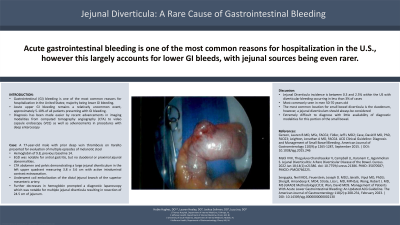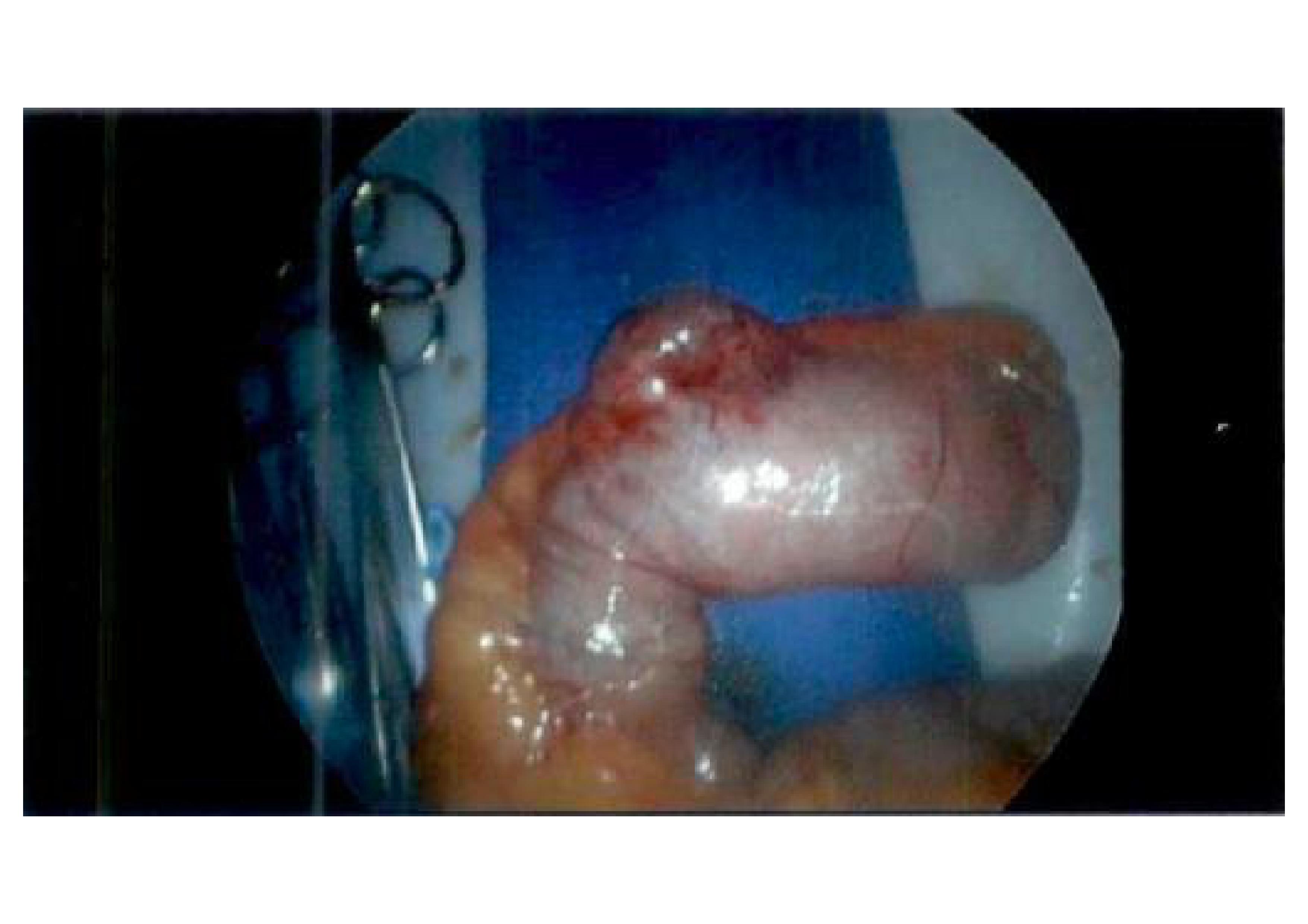Monday Poster Session
Category: GI Bleeding
P2494 - Jejunal Diverticula: A Rare Cause of Gastrointestinal Bleeding
Monday, October 28, 2024
10:30 AM - 4:00 PM ET
Location: Exhibit Hall E

Has Audio

Hobie L. Hughes, DO
Jefferson Health
Daphne, AL
Presenting Author(s)
Hobie Hughes, DO1, Lauren Healey, DO2, Joshua Soliman, DO3, Lucy Joo, DO4
1Jefferson Health, Williamstown, NJ; 2USA Health, University of South Alabama, Williamstown, NJ; 3Jefferson Health, Washington Township, NJ; 4Jefferson Health, Cherry Hill, NJ
Introduction: Acute gastrointestinal (GI) bleeding is one of the most common reasons for hospitalization in the United States, however this largely accounts for acute lower GI bleeding. Acute upper GI bleeding remains a relatively uncommon event, accounting for approximately 5-10% of all patients presenting with GI bleeding. Thanks to the recent advancements in imaging modalities from computed tomography angiography (CTA) to video capsule endoscopy (VCE) as well as advancements in procedures with deep enteroscopy, causes of small bowel bleeding can now be identified in most patients. Diverticulosis is a sac-like out-pouching of the bowel wall, and colonic diverticular bleeding is among the most common causes of acute GI bleeding. However, small bowel diverticulosis and bleeding are rarer than the more common large bowel finding.
Case Description/Methods: A 77-year-old male with a past medical history of hypertension and deep vein thrombosis on Xarelto presented for evaluation of multiple episodes of melanotic stools over the past 24 hours. He denied any recent medication changes or relevant history. Initial labs were notable for a hemoglobin of 9.8, previously noted to be 14. Gastroenterology was consulted, and he underwent an esophagogastroduodenoscopy (EGD) and colonoscopy. The colonoscopy was unremarkable. The EGD was notable for antral gastritis, but no duodenal or proximal jejunal abnormalities. A CTA abdomen and pelvis was obtained demonstrating a large jejunal diverticulum in the left upper quadrant measuring 3.8 x 3.6 cm with active intraluminal contrast extravasation. The patient underwent coil embolization of the distal jejunal branch of the superior mesenteric artery. General surgery was consulted secondary to further decreases in hemoglobin, and the patient underwent a diagnostic laparoscopy which was notable for multiple jejunal diverticula resulting in resection of 24.5 cm of jejunum.
Discussion: While acute GI bleeding is among the most common reasons for hospitalizations in the United States, this largely accounts for lower GI bleeding. Upper GI bleeding is less common but is commonly from gastric or duodenal ulcers, inflammatory bowel disease, angioectasia, or neoplasia. Small bowel diverticulosis is a rarer cause of GI bleeding with the most common location involving the duodenum, however, a jejunal diverticulum should always be a part of a differential diagnosis given the difficulty of diagnosis and often the limited availability of diagnostic modalities for this portion of the small bowel.

Disclosures:
Hobie Hughes, DO1, Lauren Healey, DO2, Joshua Soliman, DO3, Lucy Joo, DO4. P2494 - Jejunal Diverticula: A Rare Cause of Gastrointestinal Bleeding, ACG 2024 Annual Scientific Meeting Abstracts. Philadelphia, PA: American College of Gastroenterology.
1Jefferson Health, Williamstown, NJ; 2USA Health, University of South Alabama, Williamstown, NJ; 3Jefferson Health, Washington Township, NJ; 4Jefferson Health, Cherry Hill, NJ
Introduction: Acute gastrointestinal (GI) bleeding is one of the most common reasons for hospitalization in the United States, however this largely accounts for acute lower GI bleeding. Acute upper GI bleeding remains a relatively uncommon event, accounting for approximately 5-10% of all patients presenting with GI bleeding. Thanks to the recent advancements in imaging modalities from computed tomography angiography (CTA) to video capsule endoscopy (VCE) as well as advancements in procedures with deep enteroscopy, causes of small bowel bleeding can now be identified in most patients. Diverticulosis is a sac-like out-pouching of the bowel wall, and colonic diverticular bleeding is among the most common causes of acute GI bleeding. However, small bowel diverticulosis and bleeding are rarer than the more common large bowel finding.
Case Description/Methods: A 77-year-old male with a past medical history of hypertension and deep vein thrombosis on Xarelto presented for evaluation of multiple episodes of melanotic stools over the past 24 hours. He denied any recent medication changes or relevant history. Initial labs were notable for a hemoglobin of 9.8, previously noted to be 14. Gastroenterology was consulted, and he underwent an esophagogastroduodenoscopy (EGD) and colonoscopy. The colonoscopy was unremarkable. The EGD was notable for antral gastritis, but no duodenal or proximal jejunal abnormalities. A CTA abdomen and pelvis was obtained demonstrating a large jejunal diverticulum in the left upper quadrant measuring 3.8 x 3.6 cm with active intraluminal contrast extravasation. The patient underwent coil embolization of the distal jejunal branch of the superior mesenteric artery. General surgery was consulted secondary to further decreases in hemoglobin, and the patient underwent a diagnostic laparoscopy which was notable for multiple jejunal diverticula resulting in resection of 24.5 cm of jejunum.
Discussion: While acute GI bleeding is among the most common reasons for hospitalizations in the United States, this largely accounts for lower GI bleeding. Upper GI bleeding is less common but is commonly from gastric or duodenal ulcers, inflammatory bowel disease, angioectasia, or neoplasia. Small bowel diverticulosis is a rarer cause of GI bleeding with the most common location involving the duodenum, however, a jejunal diverticulum should always be a part of a differential diagnosis given the difficulty of diagnosis and often the limited availability of diagnostic modalities for this portion of the small bowel.

Figure: Figure 1: Status post small bowel resection with jejunal diverticulum as shown.
Disclosures:
Hobie Hughes indicated no relevant financial relationships.
Lauren Healey indicated no relevant financial relationships.
Joshua Soliman indicated no relevant financial relationships.
Lucy Joo indicated no relevant financial relationships.
Hobie Hughes, DO1, Lauren Healey, DO2, Joshua Soliman, DO3, Lucy Joo, DO4. P2494 - Jejunal Diverticula: A Rare Cause of Gastrointestinal Bleeding, ACG 2024 Annual Scientific Meeting Abstracts. Philadelphia, PA: American College of Gastroenterology.
